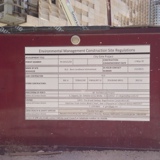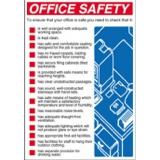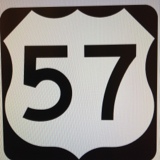Information
-
Project
-
Principal Contractor
-
Contractor/s
-
Location
-
Date and Time
-
Recieved by
-
Client
-
Prepared by
Administrative Inspection
1. Ocupational Health and Safety Plan - CR 5
-
1.1 Copy of approved OHS Plan
2. Notification of construction to the Department of Labour -CR 3
-
2.1 Proof of notification
-
2.2 Signed by Principal Contractor
-
2.3 Copy in Ohs File
3. Occupational Health an Safety Act 85 of 1993 and Regulations - GAR 4
-
3.1 Copy of OHS Act and Regulationson site
-
3.2 Readily available for perusal by employees
4. Workmans Compensation - Sect. 80, CR 4
-
4.1 Updated copy of Compensation Insurer's letter of good standing
5. Company OHS Policy - Sect. 7
-
5.1 Policy signed by C.E.O
-
5.2 Policy displayed
6. Duty to inform - Sect. 13
-
6.1 Site Rules displayed
-
6.2 Rules explained to employees
7. Risk Assessments - CR 7
-
7.1 Risk Assessor apointed in writing
-
7.2 Hazards identified and recorded
-
7.3 Risk Assessment Review Plan drawn up and updated
8. Induction and Task Safety training - Sect. 13, CR 7
-
8.1 All employees and visitors receive induction training
-
8.2 Employees and visitors carry proof of training
-
8.3 Toolbox talks done as per Risk Assessments
9. Assigned duties - Sect. 16
-
9.1 Letter of declaration by C.E.O - Sect. 16(1)
-
9.2 Responsibility of complying with the OHS Act assigned to another person/s by C.E.O - Sect. 16(2)
10. Supervising - CR 6
-
10.1 Designation of Construction Work Supervisor - CR 6(1)
-
10.2 Designation of Subordinate Construction Work Supervisor - CR 6(2)
-
10.3 Competent person appointed in writing as Construction Safety Officer - CR 6(6)
11. OHS Representatives - Sect. 17, Sect. 18
-
11.1 OHS Representative/s appointed in writing
-
11.2 Copy of OHS Representative/s training certificate
-
11.3 OHS mothly Report
12. OHS Committee - Sect. 19, Sect. 20
-
12.1 Committee members appointed in writing
-
12.2 Committee meetings held regularly
-
12.3 Meeting minutes kept in OHS File
-
12.4 Issues/Items actioned by management
13. Contractors - Sect. 37, CR 5
-
13.1 Written agreements with Contractors - Sect. 37(2)
-
13.2 Contractors appointed in writing - CR 5(3)(b)
14. Demolition - CR 12
-
14.1 Competent person appointed in writing to control and supervise all demolition work
-
14.2 Demolition work method statement
-
14.3 Competent person appointed in writing to use explosives for demolition work
-
14.4 Proof of explosives training
15. Excavations - CR 11
-
15.1 Competent person appointed in writing to examine all excavation work
-
15.2 Competent person appointed in writing to develop a method statement where explosives are involved
-
15.3 Excavations baracaded and visible
-
15.4 Excavations inspected before every shift after incliment weather
-
15.5 Register up to date
16. Formwork and Support work - CR 10
-
16.1 Competent person appointed in writing to supervise formwork an support work
-
16.2 Competent person appointed in writing to inspect formwork and support work
-
16.3 Register up to date
17. Scaffolding - CR 14
-
17.1 Competent person appointed in writing as scaffold supervisor
-
17.2 Competent person appointed in writing as a scaffold team leader
-
17.3 Competent person appointed in writing as a scaffold erector
-
17.4 Competent person appointed in writing as a scaffold inspector
-
17.5 Inspected daily after inclement weather and major alterations
-
17.6 Register up to date
18. Ladders - GSR 13A
-
18.1 Competent person appointed in writing to inspect ladders
-
18.2 Ladders numbered
-
18.3 Register up to date
19. Electrical Equipment - EMR 9, EMR 10, CR 22
-
19.1 Competent person appointed in writing to control all electrical installations
-
19.2 Certificate of Compliance issued
-
19.3 Portable Electrical Tools Inspector appointed in writing
-
19.4 Register up to date
20. Lifting Machines and Equipment - CR 17, CR 20, DMR 18
-
20.1 Competent person appointed in writing to inspect lifting machines and equipment
-
20.2 Competent person appointed in writing to operate lifting machines and equipment
-
20.3 Proof of operators' medical certificate of fitness
-
20.4 Cranes and lifting tackle identified, numbered and on register
-
20.5 Log book for each individual hoist
-
20.6 Load testing certificates for lifting machines and equipment
21. Batch Plants - CR 18
-
21.1 Competent person appointed in writing to operate and supervise batch plant operations
-
21.2 Proof of operator's training
-
21.3 Competent person appointed in writing to inspect batch plant/s
-
21.4 Register up to date
22. Concrete Mixer - GMR 4
-
22.1 Competent person appointed in writing to operate and inspect concrete mixers
-
22.2 Register up to date
23. Construction Vehicles and Mobile Plant - CR 21
-
23.1 Competent person appointed in writing to operate construction vehicles and mobile plant
-
23.2 Competent person appointed in writing to inspect construction vehicles and mobile plant
-
23.3 Register up to date
-
23.4 All relevant load testing certificates available
-
23.5 Medical certificates of fitness of operators available
24. Suspended Platforms - CR 15
-
24.1 Competent person appointed in writing to supervise the use of suspended platforms
-
24.2 Competent person appointed in writing to erect suspended platforms
-
24.3 Competent person appointed in writing to operate suspended platforms
-
24.4 Competent person appointed in writing to inspect suspended platforms
-
24.5 All relevant design certificates and calculations available
-
24.6 Inspection and test register up to date
-
24.7 All relevant load testing certificates available
-
24.8 Proof of operator/s training available
-
24.9 Medical certificate/s of fitness of operator/s available
25. Boatswains Chair - CR 16
-
25.1 Competent person appointed in writing to inspect boatswains chair daily
-
25.2 Proof of training available
-
25.3 Register up to date
26. Fall Protection - CR 8
-
26.1 Competent person appointed in writing to develop and implement a fall protection plan
-
26.2 Program includes training, inspections, testing and maintenance of equipment
-
26.3 Medical certificate of fitness for person/s working in elevated positions
27. Water Environments - CR 24
-
27.1 Method statement for working near water environments, and includes steps taken to facilitate drowning rescue
-
27.2 Suitable and sufficient lifesaving equipment supplied and worn
-
27.3 Equipment register up to date
28. Hand Tools
-
28.1 Hand tool inspector appointed in writing
-
28.2 Register up to date
29. Explosive Power Tools - CR 19
-
29.1 Competent person appointed in writing to supervise and control the use and safe keeping ofexplosive power tools and equipment
-
29.2 Competent person appointed in writing to inspect all explosive power tools before use
-
29.3 Proof of operator/s training
-
29.4 Register up to date
30. Welding and Flame Cutting - GSR 9
-
30.1 Competent person appointed in writing to inspect electric arc, gas welding and flame cutting equipment
-
30.2 Register up to date
31. Stacking and Storage - CR 26
-
31.1 Competent person appointed in writing to supervise all stacking and storage areas
-
31.2 Materials properly stacked/bonded/chocked
32. Hazardous Chemical Substances - HCR 9A
-
32.1 Competent person designated in writing to control the storage and use of HCS
-
32.2 Material safety data sheets available for HCS on site
33. Emergency Co-ordination - ER 9
-
33.1 Competent person designated in writing to co-ordinate all fire and emergency contingency planning and execution
34. Personal Protective Equipment
-
34.1 PPE issued by Principal Contractor/Contractor
-
34.2 Register up to date
35. Fire Precautions - CR 27
-
35.1 Competent person appointed in writing to inspect all fire fighting equipment
-
35.2 Fire extinguishers serviced annually
-
35.3 Register up to date
36. Incidents and Accidents - OHS Act. Sec. 24, GAR 8, GAR 9, COIDA Sec. 38, 39, 41
-
36.1 Competent person appointed in writing to investigate all incidents and accidents
-
36.2 Lost time injuries investigated and recorded
-
36.3 Lost time injuries reported to the Department of Labour within 7 days
-
36.4 Copies of investigation reports available
-
36.5 Incident/accident minuted in OHS committee meeting
-
36.6 Action taken by management to prevent a similar incident/accident
-
36.7 Cases of ocupational diseases reported
37. First Aid - GSR 3
-
37.1 First aid freely availble
-
37.2 First aid box equipped as per the list in the OHS Act
-
37.3 First aid box register up to date
-
37.4 Quaified first aider where there are 10 or more people, and an additional 1 for every 50 thereafter
-
37.5 First aider/s' certificates available
-
37.6 Record of first aid injuries kept
38. Audits - CR 5(3)(d)
-
38.1 Principal contractor conducting internal audits
-
38.2 Principal contractor monthly audits on contractor/s conducted
39. Permits
-
39.1 Valid wayleave/s available
-
39.2 Valid civil works permit available
Walk Through Inspection
40. Access
-
40.1 Site securely fenced off
-
40.2 Site access controlled
41. Compulsory Signage
-
41.1 No unauthorized entry
-
41.2 All visitors to report to site office
-
41.3 Mandatory blue and white PPE signage, e.g, hard hats, safety shoes, high viz vests, etc.
-
41.4 Emergency assembly point
42. Safety Notice Board
-
42.1 Site rules displayed
-
42.2 Company OHS policy displayed
-
42.3 Emergency evacuation plan displayed
-
42.4 List of first aiders displayed
43. Excavations
-
43.1 Excavations barracaded and visible
-
43.2 Excavations shored and braced
-
43.3 Excavation sloped to angle of repose
-
43.4 Excavated or load material, plant or equipment, is away from excavation edge
-
43.5 Existing adjoining buildings or structures not affected by excavation
-
43.6 Walkways crossing over excavations adequate and safe
44. Demolition
-
44.1 Roof and floor not overloaded with debris
-
44.2 Sufficient means of access and egress to demolition areas
-
44.3 Demolition barracaded and visible
-
44.4 Structure and adjoining structures adequately shored or braced to prevent collapse
-
44.5 Nobody working under overhanging material or structure which has not been adequately supported
-
44.6 Water, gas, electricity and similar services secured from being affected by demolition
-
44.7 All floors and stairwells where demolition is taking place adequately illuminated
-
44.8 Catch platform or net erected above entrances or passageways to protect persons passing under
-
44.9 Chute is adequately constructed and secured
-
44.10 Chute is enclosed (angle of chute is more than 45° to the horizontal)
-
44.11 Bottom of chute is fitted with a gate to control the flow of material
-
44.12 Material from chute is discharged into a container or barracaded area
-
44.13 All demolished waste and debris removed and disposed of as per the method statement
45. Fall Protection
-
45.1 All unprotected openings in floors, edges, slabs, hatchways and stairways are adequately fenced or barracaded
-
45.2 All work in elevated positions are done safely from scaffold or ladder
-
45.3 Signage conspicuously placed near edges and openings
-
45.4 Fall arrest and fall prevention equipment are suitable for the job
-
45.5 Fall arrest and fall prevention equipment are securely attached to the structure or plant
-
45.6 No persons working at height during inclement weather or where weather conditions are hazardous to the health and safety of workers
46. Scaffolding
-
46.1 Foundation firm
-
46.2 Scaffold tied to structure (Access scaffold)
-
46.3 Bracing adequate
-
46.4 Sufficient amount of platform boards
-
46.5 Platform boards in a safe working condition
-
46.6 Platform boards secure
-
46.7 Handrails adequately secured
-
46.8 Handrails correct height as per design criteria
-
46.9 Adequate access ladders / stairs provided
-
46.10 Ladders / stairs adequately secured
-
46.11 Height to base ratio correct (Free standing / mobile scaffold)
-
46.12 Outriggers being used correctly (Free standing / mobile scaffold)
-
46.13 Appropriate "safe" / "unsafe" signage posted on scaffold
-
46.14 Wheels in safe working condition (mobile scaffold)
-
46.15 Wheel swivels in a safe working condition (Mobile scaffold)
-
46.16 Brakes in a safe working condition (Mobile scaffold)
-
46.17 Toe boards adequate
-
46.18 Area underneath, and surrounding scaffold clear of material and rubble
47. Suspended Platforms
-
47.1 Outriggers correctly positioned
-
47.2












